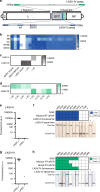Deployable CRISPR-Cas13a diagnostic tools to detect and report Ebola and Lassa virus cases in real-time
- PMID: 32807807
- PMCID: PMC7431545
- DOI: 10.1038/s41467-020-17994-9
Deployable CRISPR-Cas13a diagnostic tools to detect and report Ebola and Lassa virus cases in real-time
Abstract
Recent outbreaks of viral hemorrhagic fevers (VHFs), including Ebola virus disease (EVD) and Lassa fever (LF), highlight the urgent need for sensitive, deployable tests to diagnose these devastating human diseases. Here we develop CRISPR-Cas13a-based (SHERLOCK) diagnostics targeting Ebola virus (EBOV) and Lassa virus (LASV), with both fluorescent and lateral flow readouts. We demonstrate on laboratory and clinical samples the sensitivity of these assays and the capacity of the SHERLOCK platform to handle virus-specific diagnostic challenges. We perform safety testing to demonstrate the efficacy of our HUDSON protocol in heat-inactivating VHF viruses before SHERLOCK testing, eliminating the need for an extraction. We develop a user-friendly protocol and mobile application (HandLens) to report results, facilitating SHERLOCK's use in endemic regions. Finally, we successfully deploy our tests in Sierra Leone and Nigeria in response to recent outbreaks.
Conflict of interest statement
K.G.B., A.E.L., C.A.F., P.C.S., and C.M. are inventors on patent PCT/US2019/054561 held by the Broad Institute and related to this work. The patent covers all primers, crRNAs, and SHERLOCK technology. P.C.S. is a co-founder of, shareholder in, and advisor to Sherlock Biosciences, Inc., as well as a Board member of and shareholder in Danaher Corporation.
Figures




Similar articles
-
An Outbreak of Ebola Virus Disease in the Lassa Fever Zone.J Infect Dis. 2016 Oct 15;214(suppl 3):S110-S121. doi: 10.1093/infdis/jiw239. Epub 2016 Jul 11. J Infect Dis. 2016. PMID: 27402779 Free PMC article.
-
[Viral hemorrhagic fevers--Ebola hemorrhagic fever, Marburg virus disease, and Lassa fever].Nihon Naika Gakkai Zasshi. 2004 Nov 10;93(11):2303-8. doi: 10.2169/naika.93.2303. Nihon Naika Gakkai Zasshi. 2004. PMID: 15624463 Review. Japanese. No abstract available.
-
Epidemiology. Emerging disease or diagnosis?Science. 2012 Nov 9;338(6108):750-2. doi: 10.1126/science.1225893. Science. 2012. PMID: 23139320 No abstract available.
-
Lassa hemorrhagic fever in a late term pregnancy from northern Sierra Leone with a positive maternal outcome: case report.Virol J. 2011 Aug 15;8:404. doi: 10.1186/1743-422X-8-404. Virol J. 2011. PMID: 21843352 Free PMC article.
-
Viral haemorrhagic fevers caused by Lassa, Ebola and Marburg viruses.Adv Exp Med Biol. 2006;582:35-44. doi: 10.1007/0-387-33026-7_4. Adv Exp Med Biol. 2006. PMID: 16802617 Review. No abstract available.
Cited by
-
Detect and destroy: CRISPR-based technologies for the response against viruses.Cell Host Microbe. 2021 May 12;29(5):689-703. doi: 10.1016/j.chom.2021.04.003. Epub 2021 Apr 28. Cell Host Microbe. 2021. PMID: 33915112 Free PMC article. Review.
-
Clustered Regularly Interspaced short palindromic repeats-Based Microfluidic System in Infectious Diseases Diagnosis: Current Status, Challenges, and Perspectives.Adv Sci (Weinh). 2022 Dec;9(34):e2204172. doi: 10.1002/advs.202204172. Epub 2022 Oct 18. Adv Sci (Weinh). 2022. PMID: 36257813 Free PMC article. Review.
-
Potential Use of CRISPR/Cas13 Machinery in Understanding Virus-Host Interaction.Front Microbiol. 2021 Nov 26;12:743580. doi: 10.3389/fmicb.2021.743580. eCollection 2021. Front Microbiol. 2021. PMID: 34899631 Free PMC article. Review.
-
Highly Specific and Sensitive Detection of Yersinia pestis by Portable Cas12a-UPTLFA Platform.Front Microbiol. 2021 Jul 7;12:700016. doi: 10.3389/fmicb.2021.700016. eCollection 2021. Front Microbiol. 2021. PMID: 34305865 Free PMC article.
-
Ratiometric nonfluorescent CRISPR assay utilizing Cas12a-induced plasmid supercoil relaxation.Commun Chem. 2024 Jun 8;7(1):130. doi: 10.1038/s42004-024-01214-2. Commun Chem. 2024. PMID: 38851849 Free PMC article.
References
Publication types
MeSH terms
Substances
Grants and funding
LinkOut - more resources
Full Text Sources
Other Literature Sources
Medical

